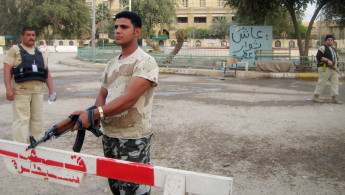Baghdad violence highlights city's sectarian split
The violence that flared up in Baghdad in the early hours of Thursday morning is the latest outbreak of sectarian tension in a conflict that has changed the very make-up of the Iraqi capital's neighbourhoods.
Shia pilgrims making their way to the shrine of Imam Musa al-Kadhim as part of an annual ritual were passing through the Sunni al-Adhamiyah district when some of the crowd began setting alight some of the houses in the area, burning 17 houses and leaving four dead, police and medical sources told AFP.
“Some elements infiltrated in the midst of the pilgrims heading to the shrine of Imam Musa al-Kadhim attacked a Sunni Waqf (endowment) building,” a police colonel said.
Police who fired into the air in an attempt to stop the violence only served to worsen it, as the crowd believed the shots were coming from locals in the area.
“We heard somebody yelling 'suicide vest, watch out'. We all started running in different directions... I was so scared I felt anyone near me was a potential suicide bomber,” a 22-year-old pilgrim, Hussein, said.
Iraqi prime minister Haider al-Abadi later visited al-Adhamiyah, blaming the events on those who “are angered by the fact that Iraqis are united in facing terrorism”.
The shrine of Musa al-Kadhim is in the Shia Kadhimiya district of Baghdad, and millions of pilgrims have walked from across Iraq. On the way, and despite heavy security from Iraqi forces, Islamic State group (IS, formerly ISIS) bombers attacked the pilgrims, with seven people killed in a car bomb attack on Saturday and six others in two attacks on Tuesday.
To get to Kadhimiya many pilgrims have to cross through al-Adhamiyah, the last Sunni-majority neighbourhood in the once mixed north-western part of Baghdad. In 2005, a stampede involving Shia pilgrims on a bridge over the Tigris out of al-Adhamiyah left 953 people dead, but local Sunnis from the neighbourhood dove into the river to rescue Shia pilgrims who had fallen in, after calls went out from local mosques.
A city divided by sect
2006, however, saw the bombing of the al-Askari shrine in Samarra, north of Baghdad, a holy site particularly revered by Shia Muslims, by IS' precursor, al-Qaeda in Iraq. This set off a tsunami of sectarian strife, as tensions that had perhaps lain dormant under dictator Saddam Hussein emerged.
Shia militias, in particular the Mahdi Army of Moqtada al-Sadr and the Iranian-backed Badr Brigade, which had control over Iraq's interior ministry, began attacking Sunnis in Baghdad, as Shias in villages and towns outside of Baghdad were simultaneously attacked by Sunni militants.
In the two years that followed Baghdad changed in a manner that cemented sectarian differences.
Columbia University' Dr Michael Izady has highlighted these changes with a series of maps showing the changes.
Once mixed neighbourhoods, the majority of the city, places like Hayy Aden, Sahab and Jihad, became affiliated with either Shias or Sunnis. Sunnis started to flee eastern Baghdad as the influence of the vast Shia-majority district of Sadr City, previously a bastion of the Iraqi Communist Party in the days when sectarian identity was not so dominant, began to be felt. Sadr City is home to the Mahdi Army, and its militiamen essentially began a campaign of ethnic cleansing.
“A relative of ours in Guraiat, a Shia enclave just north of Adhamiya [sic], found a note on his door ordering him to leave the area or else be slaughtered with his family,” a local journalist wrote in a blog for the New York Times in 2006.
The displacement was anticipated before 2006. Sunnis had always dominated Iraqi political life, especially under Saddam Hussein, and the US invasion gave the opportunity for Shias to take power. The fear was always that this would lead to reprisals against Sunnis for what many Shia felt was decades of disenfranchisement. With the added element of Sunni radical militant groups like al-Qaeda thrown into the mix, the recipe for sectarian disaster was set.
By 2008 the map of Baghdad tells the story by itself. The city is mostly divided into sectarian blocks, with few mixed neighbourhoods. The Sunnis are confined to a few areas like Kindi and Amiriya, the latter ironically a former Shia neighbourhood, while the Shia dominate the majority of the city.



